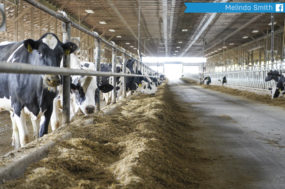Dr. Larry Fox presented on fundamental principles of milking management and mastitis – the nature of the disease and its control – to students in the Southern Great Plains Dairy Consortium (SGPDC). After the lecture, students took part in a milking system analysis laboratory exercise done on a large commercial dairy operation.
At Washington State University, we are at a disadvantage in that we are 80 miles away from the nearest commercial dairy and 150 miles from the nearest commercial dairy shed. As a result we rely on the WSU dairy center for most of our hands-on instruction.
Unfortunately standard management practices and facilities employed on the university dairy are not necessarily reflective of modern dairy operations. Also, the university dairy is small by conventional Western standards, with less than 150 lactating cows.
With the SGPDC housed in Clovis, New Mexico, we were able to take advantage of the proximity to several large, modern, commercial operations. This enhanced our ability to work with students as they practiced and demonstrated techniques.
As an example, a fundamental control mechanism for contagious mastitis is complete post-milking teat disinfection. At the WSU dairy, with slow parlor throughput, this is very easily achieved. There is just an excess of time that a cow and a milker spend in the milking parlor at the WSU dairy and thus there is more than adequate time to employ a very simple, but very effective, control technique – teat dipping.
Yet in modern dairy operations, where cattle throughput in milking parlors is three to four times faster than at the WSU dairy, often the few seconds available for teat dipping are insufficient to yield consistent results. This was easily demonstrated on one of the large commercial dairy operations we attended during one of the mastitis laboratory sections.
Within a half-hour the students witnessed the milking of over 300 cows, twice the total of the entire WSU herd. There was enough variation in the milking routine to permit an excellent assessment in teat dipping efficiency.
Not only do good instructors hope to impart knowledge, but they hope to gain some during the instructional process. Some of the students’ questions were well- thought-out and probing, creating a challenge to answer and requiring the instructor to think more deeply.
Location and contacts developed by SGPDC leaders afforded participants some very insightful opportunities. Two in particular were the visit and tour of the cross-ventilated barn and Texas diagnostic facility.
Cross-ventilated barns may be the future housing environment for dairy cattle in the U.S. Although new in concept, the one toured with the SGPDC was very well-designed and managed. When we toured that facility, the ambient temperature was 20ºF warmer than indoor conditions for the cattle.
Moreover, a slight breeze was felt inside the barn, and no hint of noxious gases was noted. Cattle were calm and comfortable and almost all, were either at the feed bunk or ruminating.
At a separate tour at the diagnostic facility, the pathologist on duty was a very able instructor. He was enthusiastic and passionate about his craft. His necropsy of a steer involved students and he gave them a real hands-on experience in the anatomy and pathology of the bovine.
These experiences for both student and instructor are invaluable and will have impact in future dairy instruction. It will be hard not to be imbued with these rich experiences; it will be easy to build upon them in future learning exercises.
Additionally, interactions with SGPDC faculty and leaders afforded all with a chance to compare notes and exchange ideas on dairy instruction in the U.S. This in itself is very important.
All too often we teach on a local level and rarely have broad contacts with other dairy instructors. Thus the SGPDC provided numerous opportunities for learning, experiential and otherwise, for both student and instructor. PD
Larry Fox
Vet Clinic Science
Washington State University
fox@wsu.edu



